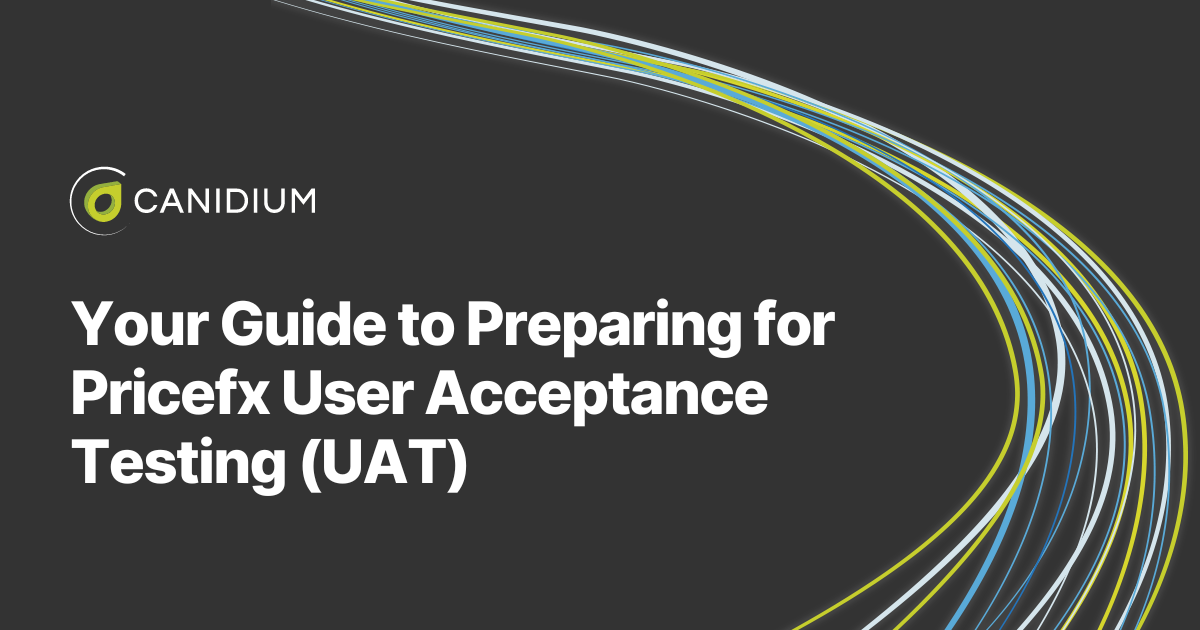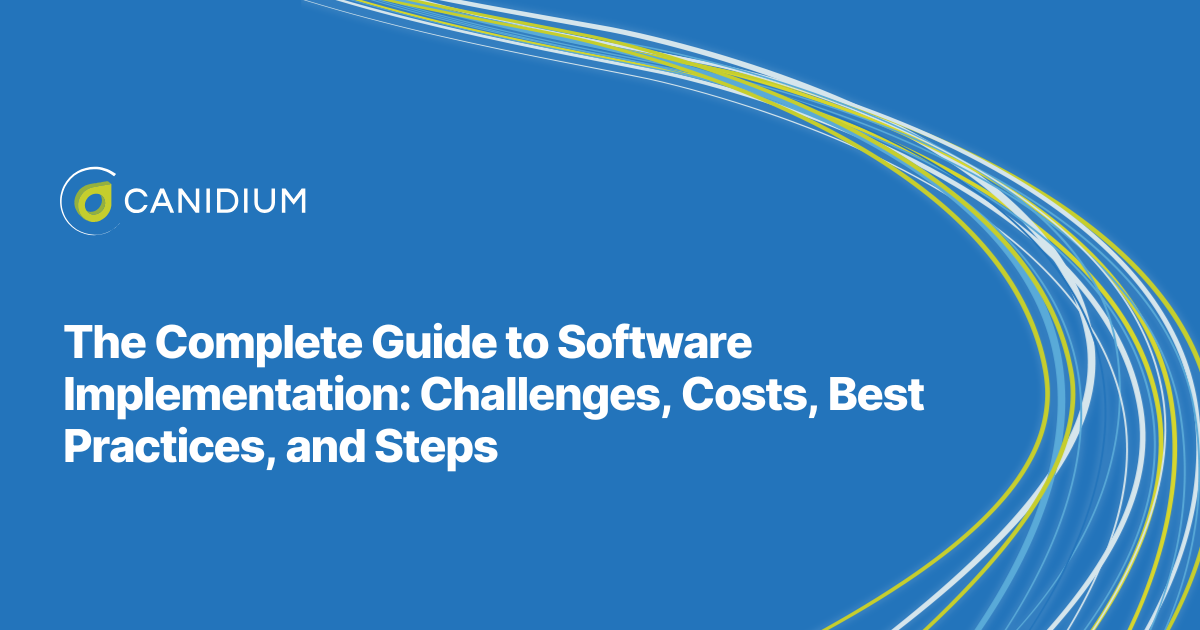Your software implementation (SI) partner handles most of your Pricefx implementation, but you will lead the process during the user acceptance testing (UAT) stage. Taking the reins is challenging when your internal implementation team has not worked with Pricefx before. You do not have experience to fall back on, and resulting missteps can lead to costly timeline delays or a ineffective testing process. However, you can overcome a lack of experience through preparation.
At Canidium, our Pricefx implementation team helps our clients prepare for a successful UAT process. We support clients before, during, and after UAT, offering first-hand experience to guide you through each step. Moreover, we prepare our clients for the process ahead of time, setting them up to lead the testing stage of the project smoothly.
Based on this expertise, we divided the entire preparation process into five steps. This guide will help you set yourself up for success by taking you through each step to take before you begin UAT:
- Scheduling Time for UAT
- Preparing Your Data
- Using Collaborative Communication Channels
- Internal Training
- Reviewing Your Success Plan
5 Steps to Take Before UAT
UAT is a critical phase in the software development process. End-users validate whether the system meets their requirements and expectations by putting the solution through its paces. This process is essential because it verifies that the software is functioning correctly, meets your business needs, and is usable by your team.
You will test the software in a real-world environment, and the end-users will give feedback on its usability, functionality, and performance. Your SI partner can then leverage this feedback to improve and optimize your Pricefx implementation accordingly.
UAT for Pricefx allows your team to validate pricing algorithms, rules, and interfaces, ensuring they comply with your business objectives and relevant regulatory requirements. It will enable your team to try different pricing scenarios and identify discrepancies or inefficiencies before deploying Pricefx. The rigor of your UAT process significantly impacts how well your partner can tailor Pricefx to your needs. It is also a chance to catch potential issues before your solution goes live. With these outcomes in mind, a smooth UAT process is vital.
The success of UAT does not solely rely on the testing phase itself. It begins long before testers even touch the software. Adequate preparation ensures that UAT runs smoothly and provides valuable insights that drive project success. The quality of the preparation determines the quality of the UAT results. If the preparation is inadequate, it can lead to delays and configuration issues. On the other hand, if the preparation is effective, it can help identify problems early, improve the software quality, and keep the project timeline intact.
To facilitate a successful UAT Pricefx implementation phase, here are the five preparatory steps you should take:
.png?width=1920&height=1080&name=5%20Steps%20to%20Take%20Before%20UAT%20(1).png)
1. Scheduling Time for UAT
Scheduling time for UAT is an often overlooked step because of its simplicity. Still, it is essential to do it ahead of time. It is not just about setting a date; it's about ensuring everyone involved has the time and focus to participate effectively.
Your internal team members have other commitments. Whether it's ongoing projects, meetings, or personal responsibilities, these can easily encroach on UAT time if not appropriately managed. To prevent scheduling conflicts, carve out time for UAT well in advance. At the same time, communicate the importance of UAT to team members early on by emphasizing its importance in meeting project deadlines and ensuring the quality of the final product.
One approach is to organize on-site UAT sessions where team members collectively dedicate uninterrupted time to testing—known as guided UAT. This approach allows for real-time collaboration, immediate issue resolution, and a sense of shared responsibility. Alternatively, if on-site sessions are impractical, ensure that remote testing is structured efficiently, with clear expectations and timelines communicated in advance.
You will need to set realistic expectations regarding UAT timing. Avoid overburdening team members with unrealistic deadlines, which can lead to rushed testing and compromised results. Instead, prioritize quality over speed to identify and address potential issues comprehensively.
While scheduling time for UAT is a simple step, it can prevent stalls in the project timeline and ensure that your team has enough time to focus on the process.
2. Preparing Your Data
Preparing your data is one of the most technical aspects of setting yourself up for the UAT process. The effectiveness of UAT hinges on the quality and accuracy of the data you are testing. If the data is incomplete, inconsistent, or inaccurate, it can lead to faulty conclusions and unreliable test results. Ideally, your data preparation process should kick off early in the configuration phase, ensuring you have a robust collection of data sets by the time UAT rolls around. You should aim for at least one to two test cases for each scenario to ensure thorough coverage and minimize potential hiccups during testing.
The goal of preparing your data is to align it with your specific pricing strategies and segmentation criteria. To prepare your data for a Pricefx implementation, focus on the following:
- Clean: Clean your data sets by eliminating duplicates, standardizing formatting, rectifying any missing values, and validating information.
- Segment: Identify and consistently apply segmentation variables across datasets to avoid misunderstandings and achieve accurate pricing strategies.
- Complete: Have complete and detailed transactional information to identify and correct margin leakage.
- Structure: Structure data in a machine-readable format to ensure seamless integration with pricing engines and avoid costly mistakes.
This process can be complex, but your SI partner can guide you. They can help you diagnose the state of your data infrastructure, provide integration guidance between CRM and ERP systems, evaluate data readiness for implementation, and offer strategic insights to optimize pricing strategies and processes.
3. Using Collaborative Communication Channels
Maintaining collaborative communication channels, like Smartsheet, with your SI partner during the UAT process is vital. A shared document provides real-time visibility into test case progress, keeping your SI partner up-to-date with the granular progression and insights generated by your team.
Traditional methods like Excel spreadsheets might help you keep track of UAT progress. However, it does not automatically send updates to your SI partner, making it easy for critical updates to slip through the cracks. Moreover, centralizing UAT management in a collaborative tool allows users to easily monitor tasks, address issues promptly, and maintain alignment throughout the process.
Establish a collaborative communication channel with your SI partner before you begin UAT testing. Ensure your UAT team is familiar with the channel and knows how to add feedback and progress updates.
4. Internal Training
Ideally, you should complete internal training before the UAT process begins. Training equips users with the necessary knowledge and skills to engage in the testing process effectively. Without adequate training, users may struggle to navigate the system, understand testing requirements, or interpret test results accurately, leading to inefficiencies and delays in the testing process.
Before entering the testing phase, internal training enables users to familiarize themselves with the pricing solution's functionalities, workflows, and best practices. This familiarity empowers users to make informed decisions, identify potential issues, and provide valuable feedback during UAT, ultimately enhancing the quality and effectiveness of testing outcomes.
At the same time, by incorporating user feedback from training sessions into the UAT process, organizations can refine training materials, reinforce key concepts, and adequately prepare users to utilize the pricing solution effectively post-implementation.
End-to-end training, conducted throughout the implementation process, is the most effective way to familiarize your organization with Pricefx. However, you want your UAT team to be familiar enough with the software to thoroughly test every aspect of the solution to avoid issues after it goes live.
Having individuals trained and familiar with the system's functionalities beforehand can facilitate the testing process. Testers can swiftly handle complex scenarios such as examining credits and commissions. This familiarity expedites the testing process and ensures you spend valuable time during UAT validating system performance rather than on training sessions.
5. Reviewing Your Success Plan
At Canidium, our clients have a user success plan to guide them through the UAT preparation and execution. This comprehensive guide outlines responsibilities, expectations, and testing scope, providing clarity and alignment for all parties involved.
Your success plan will include details regarding test case tracking, communication strategies, and escalation procedures, helping you establish a solid foundation for effective UAT execution. It also offers guidance on crafting high-quality test cases, including positive and negative scenarios, to encourage thorough testing and ensure comprehensive validation of the pricing solution.
Provide your team members with your success plan early, so they have time to prepare and navigate the testing process confidently. The success plan will help you understand how to conduct your UAT process more granularly. It offers the detailed support you need to get through this critical phase in the implementation process, during which your internal team will lead the effort.
Setting Your Company Up for a Successful UAT Process
The UAT process is a critical component of a successful implementation, and it is also the only phase during which you will take the lead. Your SI partner is in a supporting role during UAT, meaning you need to prepare to guide the effort.
Lay the groundwork for a smooth and productive UAT process by scheduling time for UAT, preparing your data, familiarizing your team with collaborative communication channels, conducting early internal training, and reviewing your success plan. These steps will ensure that you and your users are ready to participate thoroughly in the testing process, thus avoiding delays or missteps during the process.
Now that you have the tools to manage the UAT process, your next step is to prepare for the subsequent phases of a Pricefx implementation. Start by reading more about managed services after your Pricefx solution goes live.








